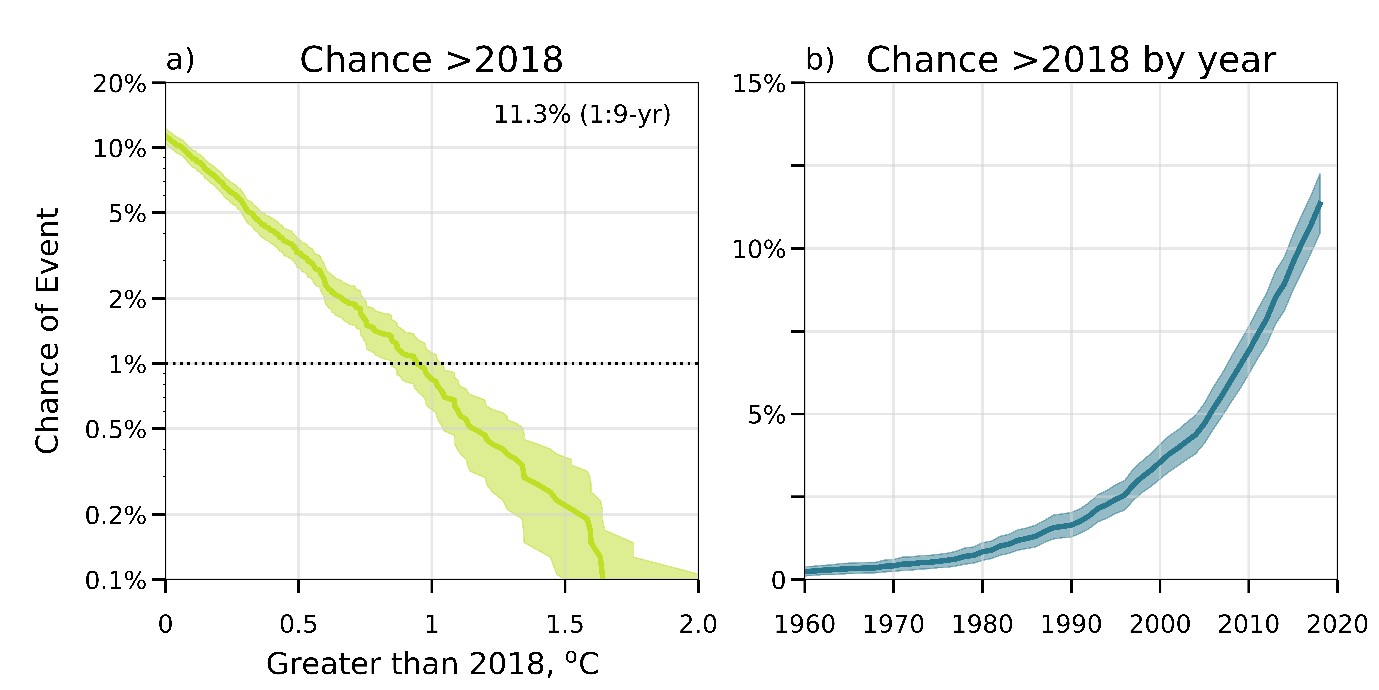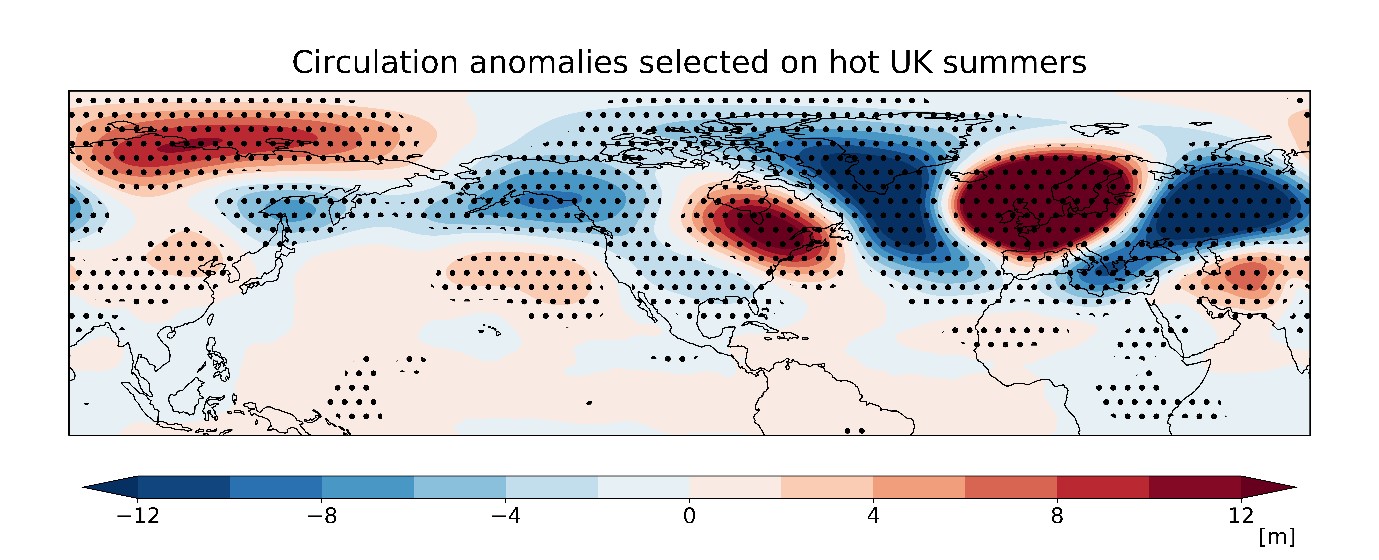What are the chances of another hot summer like 2018?
September 2020 - New study published on the likelihood in upcoming years of the UK experiencing temperatures even higher than the record heat of summer 2018.
Climate extremes such as high temperatures or drought can have major impacts on society and place a spotlight on our preparedness for and resilience to such events. Having good estimates of their current likelihood feeds into an improved assessment of risk, which in turn informs planning and policy. The new study (1) described here estimates the chance in the current climate of exceeding the UK summer temperatures of 2018 when UK mean temperature reached 15.76°C. Scientists are continuing to explore if and how the method used may be applied to different extremes in the UK and around the world.
The ‘UNSEEN’ approach
We know that the atmosphere is a chaotic system – with the flap of a butterfly’s wings, very different weather outcomes can arise from near-identical starting conditions. One of the questions that follows is how the summer temperatures that we have witnessed over the years could have looked different, or in other words: have we been lucky in the extreme temperatures that have affected the UK? Could conditions have been more severe? We only have one version of how the climate evolved in reality but what if we could simulate lots of different versions? The temperature extremes produced by these alternative versions would enable a better representation of the frequency of plausible extreme events in today’s climate.
This is the idea behind ‘UNSEEN’, UNprecedented Simulated Extremes using ENsembles. A large set of climate model simulations – or ensemble – provides the different versions of the climate. They simulate many more virtual summers than are available from observations alone, and some of these have higher temperatures across the UK than in 2018. These are conditions that are possible in the current climate but have not yet been experienced. The set of simulated summers is used to quantify the chance of seeing unprecedented high temperatures, while also enabling us to estimate how hot high-end extremes could be in today’s climate.
Estimating the chance of exceeding summer 2018 temperatures in the UK
The likelihood of exceeding the UK’s record breaking summer 2018 mean temperature of 15.76°C is estimated to be ~11% each year (Figure 1a), and much warmer temperatures are possible. An extreme of a 1 in 100-year magnitude would bring an average summer temperature of around 1°C greater than 2018. Against the backdrop of a warming climate, the chance of seeing temperatures higher than 2018 has increased rapidly over the last decades, from <1% in the 1960s to ~10% in the 2010s (Figure 1b).

Figure 1. Applying UNSEEN to UK summer temperatures. a) UNSEEN estimate of likelihood of exceeding summer 2018, with central estimate in dark green and 95% confidence interval obtained via bootstrap resampling of the ensemble in pale green. Dotted line indicates the magnitude, relative to summer 2018, of a one in 100-year event. b) Change in likelihood of exceeding 2018 over time, calculated each year from the ensemble adjusted to represent that year’s climate. 95% confidence intervals calculated as before.
The dynamics of hot summers in the UK
An important benefit of the UNSEEN dynamical approach over simple statistical estimates is that the model simulations provide us with the wider climate conditions connected to the extreme of interest, which enables insight into the dynamics behind hot UK summers. By sub-selecting the model set of 4720 simulated summers based upon high UK temperatures, we get the average atmospheric circulation signature of hot summers (Figure 2).
 Figure 2. Sub-selecting the ensemble to characterise anomalous atmospheric circulation. Composite 500 hPa geopotential height anomalies (m) selected on warmest 5% (236) simulated UK summers. Stippling marks the 90% confidence level, obtained via a t-test.
Figure 2. Sub-selecting the ensemble to characterise anomalous atmospheric circulation. Composite 500 hPa geopotential height anomalies (m) selected on warmest 5% (236) simulated UK summers. Stippling marks the 90% confidence level, obtained via a t-test.
The atmospheric circulation anomalies marked by red shading over the UK and northern Europe are indicative of warm temperatures at the surface. There is a clear wave pattern of alternating high (red) and low (blue) circulation anomalies reaching around much of the northern hemisphere, suggesting that there is influence on the UK from remote regions. The study describes possible influence from both the tropics and the Arctic, which projects onto the summer circulation over the north Atlantic and northern Europe, contributing to high temperatures over the UK.
Applying UNSEEN to other impact-relevant extremes
UNSEEN has been applied in several other cases, and research in this area is ongoing for impact-relevant extremes in the UK and around the world. Some examples follow:
UK applications of UNSEEN
- Winter rainfall: virtual observations of around 100 times more data than we have in the observed record (from 1981-2015) have been analysed, including winter months that were wetter than the record-wettest January in 2014. Research shows there is now a 7% chance of record monthly rainfall over South-East England each winter and a 1% chance of a very large increase (15-35%) beyond the current historical record (2).
- National Flood Resilience Review: the UK Government National Flood Resilience Review (2016) (3), aims to understand the risks of river and coastal flooding from extreme weather over the next 10 yrs. The inclusion of UNSEEN adds an important component to the assessment, allowing enhanced estimates of record rainfall and beyond those based only on historical observed records of river levels and flows during floods.
Global applications of UNSEEN
- High summer temperatures in China: study of heatwaves in South-Eastern China, predicting a 10% chance of an unprecedented hot month per summer (4).
- Monsoon rainfall in India: assessment of the chance of unprecedented floods or droughts during the Indian monsoon. The annual chance of extreme drought is higher than that of flooding and is linked to the El Niño Southern Oscillation. The study found although the chance is small (approx. 1 in 200-year event), a drought with a deficit of 30% is possible in the current climate (5).
- Sudden Stratospheric Warmings: a study of sudden stratospheric warming events in the Southern Hemisphere calculates the chance of this rare event as around 4% per year (6). Although rare, this event is important as it was a precursor to the Australian wildfires of 2019.
- Global food security: assessment of the likelihood of maize production being affected due to drought. A 5% annual chance of unprecedented drought events was calculated in North-East China, and the risk of this ‘multi-breadbasket failure’ of drought in China and the USA is estimated to be 6% per decade (7).
References
1. Kay G. et al. 2020. Current likelihood and dynamics of hot summers in the UK. Environ. Res. Lett. 15 094099. https://doi.org/10.1088/1748-9326/abab32
5. Jain S. et al. 2020. Current chance of unprecedented monsoon rainfall over India using dynamical ensemble simulations. Environ. Res. Lett. 15 094095. https://doi.org/10.1088/1748-9326/ab7b98
6. Wang L. et al. 2020. What chance of a sudden stratospheric warming in the southern hemisphere? Environ. Res. Lett. https://doi.org/10.1088/1748-9326/aba8c1
7. Kent C. et al. 2017. Using climate model simulations to assess the current climate risk to maize production. Environ. Res. Lett. 12 054012. https://doi.org/10.1088/1748-9326/aa6cb9





